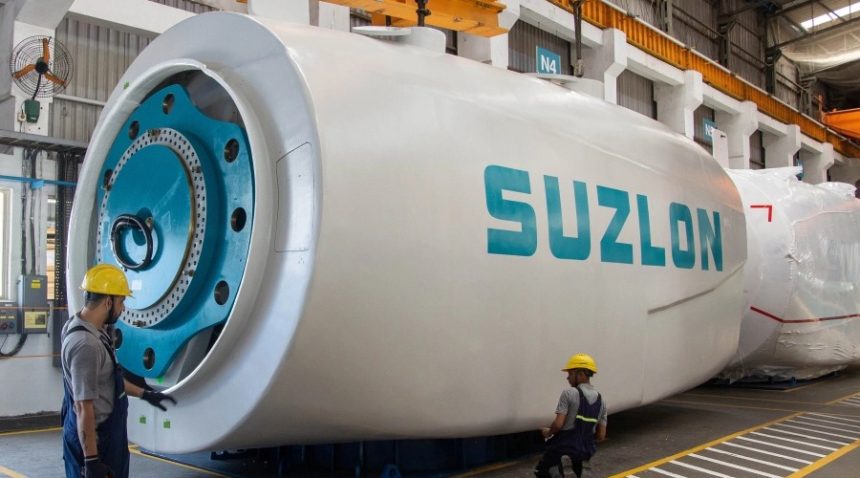Suzlon turns the page with zero debt, soaring orders & a clean energy future
Suzlon Energy, once known for its deep financial troubles and heavy debt burden, has now become one of India’s most inspiring corporate comeback stories. The company, a key player in the wind energy sector, has closed a long and difficult chapter in its history and entered a new era marked by rising profits, a strong order book, and complete freedom from debt. This transformation reflects years of hard work, smart planning, and a growing demand for clean energy in India and around the world.
From Debt-Laden to Debt-Free
Just a few years ago, Suzlon was struggling under a huge debt burden. In the financial year 2020, the company owed around ₹13,210 crore in interest-bearing loans. This debt had become a serious obstacle, affecting operations and limiting growth. However, the company took bold steps to turn things around. It sold off non-core assets, reduced unnecessary costs, and restructured its operations to become leaner and more efficient.
By the end of the financial year 2025, Suzlon had successfully paid off nearly all its borrowings. The total debt came down to ₹283 crore, while the company had cash reserves of ₹2,227 crore. This resulted in a net cash position of ₹1,943 crore, making Suzlon officially debt-free. Becoming debt-free also meant that the company no longer had to pay around ₹800 crore in annual interest, which improved profitability and allowed more funds to be directed toward new projects and growth.
Record-Breaking Profits in FY25
Suzlon’s financial performance in FY25 was its best in more than a decade. The company reported an annual net profit of ₹2,072 crore, a major jump from ₹722 crore the previous year. In the fourth quarter alone, Suzlon made a profit of ₹1,181 crore, compared to ₹281 crore in the same quarter last year. This dramatic rise in profits shows how much the company has improved.
Revenue growth was equally strong. The total income for FY25 reached ₹10,851 crore, up 67% from the previous year. Operating profits (EBITDA) grew by 81% to ₹1,857 crore. This growth was supported by higher sales, better cost control, and strong demand for wind energy installations.
What stands out is that Suzlon has now posted profits for 12 quarters in a row. This consistent profitability indicates that the turnaround is not temporary but is built on solid ground.
Strong and Growing Order Book
Suzlon’s order book has also seen a major boost. By the end of FY25, the company had secured firm orders for 5.6 gigawatts (GW) of wind energy projects. This includes major contracts from large organizations such as NTPC Green (378 MW), Bharat Petroleum Corporation Limited (BPCL, 50.4 MW), and Sunsure Energy (100.8 MW). More recently, in June 2025, Suzlon signed a 170.1 MW deal with AMPIN Energy Transition.
These orders are for both wind-only and hybrid (wind plus solar) projects, showing Suzlon’s flexibility and capability in different renewable energy setups. A few years ago, Suzlon was short of money and struggling to win new orders. Today, the company is in a position to deliver 3 to 4 GW of capacity each year through FY26. This is expected to push revenue growth by 20–25% annually over the next couple of years.
Technology That Sets the Pace
One reason for Suzlon’s success is its strong technology. The company’s S144 wind turbine has become a popular choice in India’s low-wind regions. This turbine, part of the 3 MW category, features a rotor diameter of 144 meters. It offers 15–20% higher energy output compared to older models and reduces installation costs by about 8%. These advantages make it a top choice for customers looking for cost-effective and efficient energy solutions.
Suzlon also scaled up its manufacturing to meet growing demand. In FY25, the company delivered 1,550 MW of wind energy equipment—more than double the amount delivered in FY24. It added ten new production lines and expanded its nacelle assembly facilities in Daman and Puducherry.
The company’s operations and maintenance (O&M) business has become a reliable source of income. Suzlon now manages 15.1 GW of wind assets and earned ₹1,928 crore in annuity income through this division, with a high operating margin of 40%. Another unit, SE Forge, which supplies machine components, contributed ₹489 crore in revenue with a 15% profit margin.
Cleaner Governance and Market Confidence
In June 2025, the Securities and Exchange Board of India (SEBI) officially closed its legal case against Suzlon. This move restored market trust and showed that the company had resolved past governance concerns.
However, earlier this year, the founding Tanti family sold a stake worth around ₹1,300 crore. While such sales usually raise concerns, the market remained stable, suggesting investors had confidence in the company’s long-term plans.
Ambitious Targets for FY26
Looking ahead, Suzlon is aiming high. The company has set a goal to grow its revenue, profit, and deliveries by 60% in FY26. Analysts from top financial firms expect a steady 20–25% annual growth in revenue. The share price has also gained attention, currently trading around ₹65.5, with future targets set in the ₹80 range by several brokerages.
The company stands to benefit from new government policies that support renewable energy. India’s growing demand for green power, combined with stricter rules for companies to buy clean electricity, is likely to help Suzlon win more orders. The government’s push for local manufacturing also benefits Suzlon as an Indian wind turbine maker.
Risks That Still Exist
Despite the strong turnaround, some risks remain. Delays in land acquisition, grid connections, or transportation could affect project execution. The company’s receivables have also increased, as some customers—especially state-owned electricity distributors—tend to delay payments. This could affect cash flow in the short term.
Rising costs of raw materials such as steel and copper might reduce profit margins, especially if these increases cannot be passed on to customers. Any future stake sales by promoters or management changes could also unsettle investors. Finally, solar energy remains a tough competitor, especially in hybrid energy bids.
Suzlon’s journey from deep financial trouble to a strong and growing clean energy giant shows how companies can recover through smart decisions, innovation, and discipline. With no debt, rising profits, and strong demand for wind energy, Suzlon is better prepared than ever to lead India’s renewable energy future. The challenges are not over, but the foundation is strong, and the outlook is brighter than ever.





